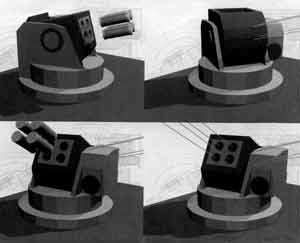| Designation: | Reactor |
 |
|---|---|---|
| Manufacturer: | HELIO | |
| Product type: | Screen Laying Systems | |
| Name: | Grenade launcher |
Early in 1999, it was revealed that a UK based consortium, headed by the Helio company, was developing as a private venture a future obscurant launcher system called Reactor. This has been designed to improve the survivability of combat vehicles on the battlefield.
Current smoke grenade launchers are normally mounted on either side of the armoured vehicle turret and cover the frontal arc. They are usually operated by the vehicle commander and launch smoke grenades, or other types of grenades, forward and to the left and right of the vehicle.
The main drawback of these systems is that they do not cover a full 360° arc and once the grenades have been launched they have to be manually reloaded from outside the turret.
Not only is this a time consuming process, but on the battlefield can be very dangerous to the crew, especially under NBC conditions. Also, if the vehicle is on a slope the coverage of the fixed grenade launcher is not always satisfactory.
The next stage is to add a laser warning system to form a basic DAS. This alerts the crew to the direction of the laser, which can be a laser range-finder or even a laser beam from a laser guided missile. The turret is then traversed in the direction of the threat and engaged with the main armament of the vehicle and/or the grenade launchers activated.
Atypical recent DAS is the Helio Cerberus integrated laser detection and smoke discharger system. This integrates Avimo LWD 2 laser warning detectors, coupled to a Helio control and display panel and grenade launchers.
A complete Helio Cerberus DAS offers the user automatic or manual discharge of grenades through a full 360° as the grenade launchers are positioned at each corner of the turret, as are the laser detectors. When used in automatic mode there can be 180° automatic discharge centred on the direction of threat.
While such DAS is an improvement, it still suffers from the major tactical disadvantage that it cannot be reloaded from within the vehicle. Until the launchers are reloaded the vehicle is vulnerable to attack and subsequent destruction.
Against this background, Helio are currently developing Reactor as a cost effective and affordable part of a DAS. Reactor is a steerable and reloadable obscurant launcher system. While Helio are taking the overall lead in development of the launcher, FHL is working on the automatic loader and Pains Wessex on the grenades.
Inatypical installation the Reactor launcherwould be mounted on the top of the vehicle turret where it would have full 360° coverage in azimuth and -30 to +40° in elevation.
Reactor can rapidly provide multiple screens in the required direction. If required, the platform could have two Reactor Launchers, each of these covering 180°.
The Reactor launcherwould have a cassette loaded with four munitions, in the ready to launch position. This would be sufficient for one screen before reloading takes place. Each cassette would accommodate existing 66 and 76 mm munitions, although custom-designed multispectral grenades would be the preferred choice.
The electrically loaded magazine would carry out a complete reload from under armour in about three seconds with the magazine holding an additional three cassettes.
Information from the laser detectors would be fed into the DAS controller. This in turn would supply information to the Reactor interface unit comprising the launcher head and the reloading magazine.
On receiving threat information this would be rapidly assessed and if confirmed as hostile, the Reactor launcherwould traverse in line with the target and at the correct time launch its grenades.
It is envisaged that Reactor would form part of an overall DAS which would also include radar warning receivers, missile approach warners and thermal imaging/TV sensors.
Built in test would be standard and Reactor would also take into account vehicle attitude, heading and speed as well as ambient wind velocity which has major impact on obscurants.
As any platform is likely to remain in service for a considerable period, Reactor is being designed with growth potential, for example, a stabilisation system. Further in the future, is anticipated a hard kill capability.
In development.
 |
